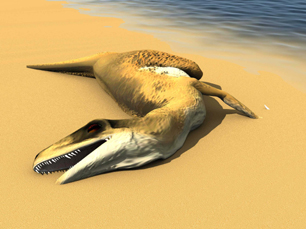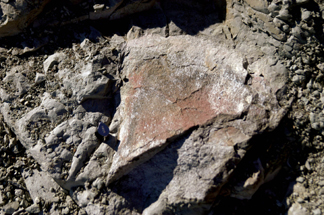Geotimes

Web Extra
Monday, March 8, 2004
Dinosaurs in the cold, dark
Antarctic
 Washington,
DC — Paleontologists recently unearthed two Antarctic dinosaurs'
skeletons, representing two new species from very different time periods on
the southern continent. The principal investigators from the two teams made
a joint announcement on Feb. 26, at a press conference by the National Science
Foundation, which sponsored their work. So far, both new species — one
a surprisingly large meat-eater and the other a much older and larger plant-eater
— remain unnamed until their finders can describe them in the literature.
Washington,
DC — Paleontologists recently unearthed two Antarctic dinosaurs'
skeletons, representing two new species from very different time periods on
the southern continent. The principal investigators from the two teams made
a joint announcement on Feb. 26, at a press conference by the National Science
Foundation, which sponsored their work. So far, both new species — one
a surprisingly large meat-eater and the other a much older and larger plant-eater
— remain unnamed until their finders can describe them in the literature.
An artist's rendering of what a newly
found theropod (meat-eating) dinosaur might have looked like when it died, around
70 million years ago. Image courtesy of the National Science Foundation.
A team led by Judd Case, a paleontologist at St. Mary's College of
California in Moraga, found bones typical of a land dinosaur. In life, the specimen
would have been 300 to 400 pounds and about 5 feet 10 inches tall, much larger
than most dinosaurs living on Antarctica in the Late Cretaceous.
The first question to answer, Case said, was whether the bones were from a vegetarian
or a carnivore. Luckily, the team found foot bones, including the tibia, fibula,
ankle joint and tops of large bones of the feet, as well as teeth and upper
and lower jaw pieces. "We had the important pieces to tell us a lot about
lifestyle," Case said.
By rebuilding the feet, and examining the curvature of the bones and their angles
of extension, Case and his co-workers decided they had a runner. They also determined
the animal was a meat-eater, with "teeth [that] curve backward like other
known meat-eating dinosaurs," Case said.
The dinosaur matches other theropod carnivores, such as Allosaurus and Eustreptospondylus
species, found elsewhere. However, the specimen has very "generalized"
feet characteristics, indicating that it was "primitive" — and
a precursor to the later Tyrannosaurus rex and Velociraptor, Case
said.
At the time that this creature lived, 70 million years ago and toward the end
of the "age of dinosaurs," the Antarctic was a lush but cool region,
like coastal Oregon today. Plant species such as big trees and large ferns would
have fed several of the plant-eating dinosaurs already discovered in the area.
The population assemblage is considered "relict," as most of the dinosaurs
already documented are "better known from other places at other times,"
Case said. But for some unknown reason, they still existed in the Antarctic
(though they may have evolved into something else or disappeared in other habitats
at other times). The region was the last to be colonized by flower-bearing plants.
Oddly enough, the team discovered this particular specimen buried in deep water-lain
sediments. The rocks are now exposed at Dagger Peak, on James Ross Island at
the end of the Antarctic Peninsula. One hypothesis of how the dinosaur's skeleton
ended up buried at the bottom of an ancient ocean, a precursor to the Weddell
Sea, involves some artistic license: the dinosaur may have died on a beach,
washed to sea, and then settled on the seafloor.
 A few days after
Case and his team hit upon their skeleton, Bill Hammer of Augustana College
in Rock Island, Ill., and his team of researchers found a dinosaur 2,000 miles
further south and inland, on Antarctica's Mt. Kirkpatrick. The rocks are 120
million years older than those that held the meat-eater; they yielded an even
more primitive species, preserved in its "natural habitat" alongside
a river, Hammer said at the press conference.
A few days after
Case and his team hit upon their skeleton, Bill Hammer of Augustana College
in Rock Island, Ill., and his team of researchers found a dinosaur 2,000 miles
further south and inland, on Antarctica's Mt. Kirkpatrick. The rocks are 120
million years older than those that held the meat-eater; they yielded an even
more primitive species, preserved in its "natural habitat" alongside
a river, Hammer said at the press conference.
The pelvis of a large plant-eating dinosaur,
possibly a sauropod, was found by a team led by Bill Hammer. The dinosaur skeleton
was preserved in basalt and sediments alongside a river. Photo by William Hammer,
courtesy of the National Science Foundation.
The rock-climbing guide who accompanied the team had stumbled across chunks
of petrified wood and a piece of pelvis. The illium, which is the flat part
of the pelvis, measures 2 to 3 feet long, Hammer said.
The size of the pelvis indicates a large beast. Hammer said that from that bone
and others, the dinosaur was probably a sauropod, "a big long-necked, long-tailed
plant-eater. It could be the oldest in the world," he said, though not
the biggest (which are about 80 to 100 feet long).
Hammer's team brought back the pelvis and pieces of the vertebral column to
study in his lab. Meanwhile, the rest of the skeleton is being transported in
3,000 pounds of rock matrix on a slow ship, which will return to the United
States later this spring.
"We always try to find new localities in different ages," said Hammer,
whose previous trip to Antarctica yielded a prosauropod from even earlier in
the continent's history.
"There are not many opportunities to go there," Case said. "Antarctica
still holds some surprises for us."
Naomi Lubick
Links:
National
Science Foundation Web site with streaming video
Hammer's Web site
Case's Web site
Back to top
 Washington,
DC — Paleontologists recently unearthed two Antarctic dinosaurs'
skeletons, representing two new species from very different time periods on
the southern continent. The principal investigators from the two teams made
a joint announcement on Feb. 26, at a press conference by the National Science
Foundation, which sponsored their work. So far, both new species — one
a surprisingly large meat-eater and the other a much older and larger plant-eater
— remain unnamed until their finders can describe them in the literature.
Washington,
DC — Paleontologists recently unearthed two Antarctic dinosaurs'
skeletons, representing two new species from very different time periods on
the southern continent. The principal investigators from the two teams made
a joint announcement on Feb. 26, at a press conference by the National Science
Foundation, which sponsored their work. So far, both new species — one
a surprisingly large meat-eater and the other a much older and larger plant-eater
— remain unnamed until their finders can describe them in the literature.
 A few days after
Case and his team hit upon their skeleton, Bill Hammer of Augustana College
in Rock Island, Ill., and his team of researchers found a dinosaur 2,000 miles
further south and inland, on Antarctica's Mt. Kirkpatrick. The rocks are 120
million years older than those that held the meat-eater; they yielded an even
more primitive species, preserved in its "natural habitat" alongside
a river, Hammer said at the press conference.
A few days after
Case and his team hit upon their skeleton, Bill Hammer of Augustana College
in Rock Island, Ill., and his team of researchers found a dinosaur 2,000 miles
further south and inland, on Antarctica's Mt. Kirkpatrick. The rocks are 120
million years older than those that held the meat-eater; they yielded an even
more primitive species, preserved in its "natural habitat" alongside
a river, Hammer said at the press conference. 